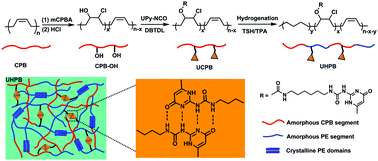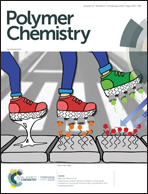One-way and two-way shape memory effects of a high-strain cis-1,4-polybutadiene–polyethylene copolymer based dynamic network via self-complementary quadruple hydrogen bonding†
Abstract
A high-strain shape memory polymer, cis-1,4-polybutadiene–polyethylene (CPB-PE) semicrystalline copolymer with 2-ureido-4[1H]pyrimidinone (UPy) side groups (UHPB), was synthesized by grafting UPy groups onto CPB and a subsequent partial hydrogenation reaction. In the shape memory process, the robust physical crosslinking via hydrogen bonding through UPy dimerization provided the permanent network, while the crystalline PE segments served as a switching phase to afford the temporary network. The broad melting transition ranging from 35.1 to 84.2 °C allowed this material to achieve multi-shape memory behaviors by choosing two and more switching temperatures within or above the melting transition. The shape memory performance was markedly influenced by the selected critical switching temperature; in other words, the shape fixity and recovery were dependent on the fraction of the recrystallized and remelted PE phase during shape fixing and recovery processes, respectively. The two-way shape memory effect under a constant load of this system was also attained by the crystallization-induced elongation and melting-induced contraction of the PE segments in UHPB. Moreover, UHPB exhibited an excellent recoverable high-strain capacity; the shape recovery reached 96.2% at a high strain of 480%.



 Please wait while we load your content...
Please wait while we load your content...